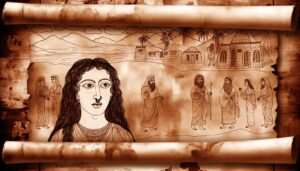Daystar Meaning In The Bible: Hope and Illumination
In biblical context, the term ‘Daystar‘ signifies profound theological symbolism, often aligning with hope and divine revelation. In the Old Scriptures, Isaiah 14:12 references ‘Daystar’ (Hebrew ‘Helel’) denoting the fall of a once-glorious entity, reflecting themes of divine justice and rebellion.
The New Scriptures employs ‘Daystar’ in 2 Peter 1:19 to symbolize Christ’s eschatological return, embodying transformative spiritual illumination. Additionally, Revelation 22:16 underscores Jesus as the ‘bright morning star,’ affirming His messianic mission.
The multifaceted interpretations of ‘Daystar’ illustrate its rich theological significance and invite deeper exploration into biblical exegesis and themes.

Daystar Meaning in the Bible: Symbol of Light, Hope, and Christ
| Aspect | Description |
|---|---|
| Term Definition | Daystar refers to the morning star or light-bringer |
| Key Scripture | 2 Peter 1:19 – “Until the day dawns and the day star arise in your hearts” |
| Symbolism | Light, hope, truth, and divine revelation |
| Associated with Christ | Represents Jesus as the source of spiritual illumination |
| Alternate Translation | Often rendered as “morning star” in various Bible versions |
| Contrast in Isaiah 14:12 | “Lucifer” once referred to as morning star in a fallen context |
| Spiritual Meaning | Awakening of truth and righteousness in the believer’s heart |
| Relevance Today | Encourages believers to let Christ’s light guide their lives |
Biblical References to Daystar

In what contexts does the term ‘Daystar‘ appear within the biblical canon, and how does its usage inform our understanding of its theological significance?
The term ‘Daystar’ is primarily found in passages that carry significant metaphorical and symbolic weight. Its appearances, though limited, are pivotal for theological exegesis.
The term, often synonymous with ‘morning star,’ is alluded to in prophetic literature and apocalyptic visions. This celestial imagery typically symbolizes hope, renewal, and divine revelation.
Its usage underscores the anticipated arrival of a new era, marked by spiritual enlightenment and redemption.
Theologically, ‘Daystar’ is intricately connected to messianic expectations and eschatological themes, offering deep insights into biblical narratives that emphasize the triumph of divine light over darkness.
Daystar in the Old Testament

The term ‘Daystar’ in the Old Scriptures is particularly encountered in Isaiah 14:12, where it is used to describe the fall of a luminous being, often interpreted as a metaphor for the downfall of the Babylonian king or, in a broader theological context, Satan.
The Hebrew word ‘Helel’ (translated as ‘Daystar’ or ‘Lucifer’ in the Vulgate) signifies a bright, shining entity, analogous to the morning star.
The prophetic imagery employed by Isaiah serves to underscore the stark contrast between the former glory and subsequent humiliation of this figure.
This passage has been pivotal in shaping Judeo-Christian perspectives on pride, rebellion, and divine justice, encapsulating the ultimate consequences of hubris and defiance against divine authority.
Daystar in the New Testament

A notable reference to ‘Daystar‘ in the New Scripture is found in 2 Peter 1:19, where it symbolizes the eschatological hope and the illuminating presence of Christ in the believer’s life.
The term ‘φωσφόρος’ (phosphoros), translated as ‘Daystar’ or ‘morning star,’ is utilized to convey the anticipatory nature of Christ’s return and His role as a divine light guiding believers.
This passage underscores the transformative power of Christ’s light, which penetrates the darkness of ignorance and sin, leading to spiritual enlightenment.
The ‘Daystar’ metaphor enriches the theological understanding of Christ’s redemptive mission, indicating a future fulfillment and the assurance of divine revelation becoming fully manifest in the hearts of the faithful.
Symbolism of Light and Guidance

Through various biblical texts, the symbolism of light serves as a profound metaphor for divine guidance and spiritual illumination.
The recurring theme of light in Scripture often represents God’s presence, truth, and righteousness, contrasting sharply with darkness, a symbol of ignorance and evil.
In Psalms 119:105, ‘Your word is a lamp to my feet and a light to my path,’ highlights the role of divine revelation in steering life’s complexities.
Furthermore, the prophetic literature, especially Isaiah 60:1, ‘Arise, shine, for your light has come,’ underscores the eschatological hope tied to divine intervention.
These passages collectively illuminate the intrinsic association between light and divine guidance, providing a rich exegetical framework for understanding the metaphor as both immediate and future-oriented.
Daystar and Jesus Christ

The term ‘Daystar‘ in biblical exegesis often symbolizes Jesus Christ, representing both His divine illumination and guidance.
This symbolism is intricately linked to various Old Scriptures prophecies which find their fulfillment in the New Scriptures, affirming Christ’s messianic role.
Symbolism of Daystar
In biblical exegesis, the term ‘Daystar‘ is often interpreted as a messianic title that signifies Jesus Christ’s role as the bringer of spiritual illumination and truth.
The symbolism of the Daystar, or morning star, heralds a new dawn, representing the transformative power of Christ’s presence and teachings. It evokes imagery of light piercing through darkness, suggesting the eradication of ignorance and sin.
In 2 Peter 1:19, the Daystar rising in hearts symbolizes the inner awakening and enlightenment that comes through faith in Christ.
This metaphor underscores Jesus’ divine mission to guide humanity toward redemption and eternal life, serving as a beacon of hope and divine revelation in Christian theology.
Prophecies and Fulfillment
Examining the prophetic literature, one finds that the imagery of the Daystar is intricately woven into the messianic expectations fulfilled by Jesus Christ, demonstrating his role as the anticipated bringer of divine truth and salvation.
In 2 Peter 1:19, the metaphor of the ‘morning star‘ rising in believers’ hearts signifies the enlightening presence of Christ.
Additionally, Revelation 22:16 explicitly identifies Jesus as the ‘bright morning star,’ fulfilling Isaiah’s prophecies concerning a light for the nations (Isaiah 42:6).
These references encapsulate Jesus’ mission to illuminate spiritual ignorance and guide humanity toward redemption.
Consequently, the Daystar motif encapsulates the theological assertion that Christ’s advent consummates Old Covenant anticipations, affirming his divine authority and salvific purpose.
Daystar and Lucifer

The term ‘daystar‘ has its origins in the Latin word ‘lucifer,’ meaning ‘light-bringer’ or ‘morning star,’ which has led to complex interpretations in biblical texts.
This duality is particularly evident in Isaiah 14:12, where ‘Lucifer’ is depicted as a fallen figure, contrasting sharply with the positive connotations of the morning star elsewhere in scripture.
Origins of the Term
With roots tracing back to ancient Hebrew and Greek texts, the term ‘Daystar‘ (or ‘Lucifer‘) has undergone significant semantic evolution within biblical literature.
In Hebrew, ‘Helel ben Shachar‘ (translated as ‘shining one, son of dawn’) appears in Isaiah 14:12, referring to a Babylonian king. The Septuagint, a Greek translation of Hebrew scriptures, rendered ‘Helel’ as ‘Phosphoros‘ or ‘bringer of light’. Jerome’s Latin Vulgate later translated this as ‘Lucifer’, meaning ‘light-bearer‘.
Over centuries, Christian exegesis began associating ‘Lucifer’ with Satan, despite its original connotations.
The term ‘Daystar’ therefore illustrates the intricate interplay between linguistic translation, historical context, and theological interpretation, reflecting its layered and evolving significance in biblical exegesis.
Biblical Interpretations Explored
Understanding the semantic shift from ‘Daystar‘ to ‘Lucifer‘ necessitates a thorough examination of biblical passages and theological commentaries that have shaped these terms’ interpretations.
The term ‘Daystar’ appears in Isaiah 14:12, where it is translated from the Hebrew word *helel*, meaning “shining one” or “morning star.” Early Christian theologians, influenced by the Latin Vulgate’s translation of *helel* as ‘Lucifer,’ associated this term with Satan’s fall from grace.
This linkage, however, is debated among scholars, as some argue that the passage contextually refers to the Babylonian king.
The exegetical challenge is to discern whether ‘Daystar’ and ‘Lucifer’ serve as metaphors for broader spiritual truths or specific historical entities, reflecting the complexities within biblical hermeneutics.
Theological Interpretations of Daystar

How does the term ‘Daystar‘ function within various theological frameworks to convey differing interpretations of its biblical significance?
Within Christian theology, ‘Daystar’ often symbolizes Christ, drawing from 2 Peter 1:19 which references the ‘morning star‘ rising in believers’ hearts, signifying enlightenment and divine revelation.
Conversely, in certain patristic writings, ‘Daystar’ is linked to Lucifer, reflecting his fall from grace as depicted in Isaiah 14:12. This duality of interpretation underscores the complexity of biblical exegesis, where context and doctrinal perspectives shape understanding.
In addition, some theologians view ‘Daystar’ as a metaphor for hope and renewal, emphasizing its role in eschatological prophecy.
As a result, ‘Daystar’ encapsulates a spectrum of meanings, each enriching the theological discourse surrounding its biblical usage.
Conclusion
In summation, the term ‘Daystar‘ encompasses multifaceted theological significances within biblical texts, both in the Old and New Scriptures.
Symbolizing light and guidance, the Daystar is intricately associated with Jesus Christ, while also bearing connections to Lucifer in specific contexts.
These dual references underscore the complex interplay of divine illumination and fallen splendor.
Theological interpretations consequently reveal the profound depth and nuanced understanding necessary for exegetical scholarship in biblical studies, akin to deciphering an ancient code.






